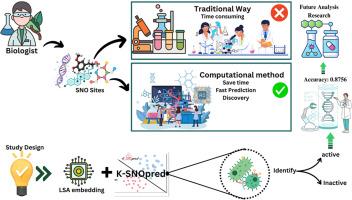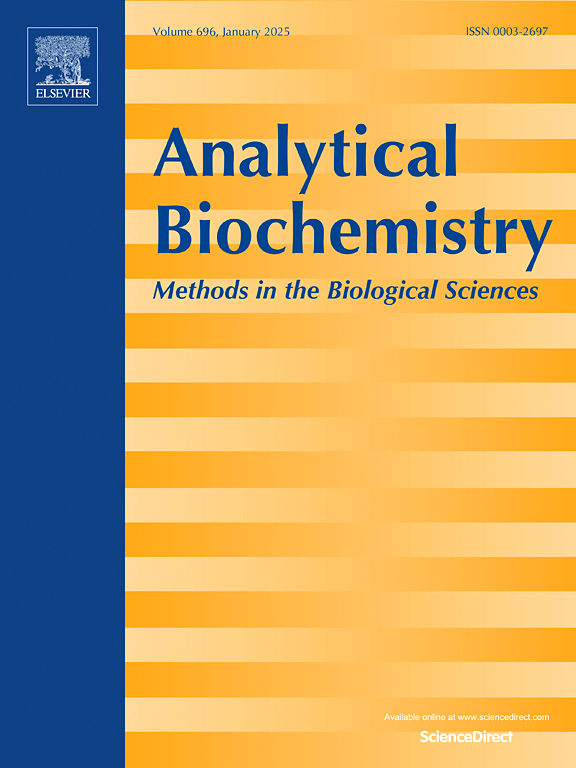K-SNOpred: Identification of protein S-nitrosylation sites through word embedding features and machine learning
IF 2.5
4区 生物学
Q2 BIOCHEMICAL RESEARCH METHODS
引用次数: 0
Abstract
Protein S-nitrosylation (SNO) is a process involving the covalent modification of cysteine residues by nitric oxide (NO) and its derivatives. Numerous studies have demonstrated that SNO is significantly involved in cell function and pathophysiology. The identification of SNO sites is significant in clarifying their function in cellular physiology, disease processes, and potential treatment strategies, rendering it of paramount importance in medical science. This study developed a machine learning (ML) model named “K-SNOpred” and found notable performance in identifying SNO sites using the Latent Semantic Analysis (LSA) feature embedding system. After collecting dbSNO and RecSNO datasets from the literature search, we applied three feature embedding systems: Doc2vec, FastText, and LSA on each dataset. The study employed various ML models and assessed their performance using multiple evaluation metrics through independent testing and 10-fold cross-validation. The evaluation's outcomes demonstrate that the proposed model achieved an accuracy of 87.56 % and an AUC score of 95.06 %, outperforming existing state-of-the-art (SOTA) models by nearly 10 % in accuracy and 6 % in AUC. Furthermore, the model demonstrated balanced sensitivity and specificity, indicating its ability to detect both positive and negative SNO sites accurately. The outstanding performance of the K-SNOpred model demonstrates its high potential for clinical use and its applicability in the biotechnology field.

K-SNOpred:通过词嵌入特征和机器学习识别蛋白质s -亚硝基化位点。
蛋白质s -亚硝基化(SNO)是一氧化氮(NO)及其衍生物对半胱氨酸残基进行共价修饰的过程。大量研究表明,SNO在细胞功能和病理生理中起着重要作用。SNO位点的鉴定对于阐明其在细胞生理学、疾病过程和潜在治疗策略中的功能具有重要意义,因此在医学上具有至关重要的意义。本研究开发了一个名为“K-SNOpred”的机器学习(ML)模型,并发现使用潜在语义分析(LSA)特征嵌入系统在识别SNO位点方面具有显着的性能。在从文献检索中收集dbSNO和RecSNO数据集之后,我们在每个数据集上应用了三种特征嵌入系统:Doc2vec、FastText和LSA。本研究采用了多种机器学习模型,并通过独立测试和10倍交叉验证使用多种评估指标评估其性能。评估结果表明,该模型的准确率为87.56%,AUC分数为95.06%,比现有的最先进(SOTA)模型的准确率和AUC分数分别高出近10%和6%。此外,该模型表现出平衡的敏感性和特异性,表明其能够准确检测阳性和阴性SNO位点。K-SNOpred模型的卓越性能表明其在临床应用和生物技术领域的适用性方面具有很高的潜力。
本文章由计算机程序翻译,如有差异,请以英文原文为准。
求助全文
约1分钟内获得全文
求助全文
来源期刊

Analytical biochemistry
生物-分析化学
CiteScore
5.70
自引率
0.00%
发文量
283
审稿时长
44 days
期刊介绍:
The journal''s title Analytical Biochemistry: Methods in the Biological Sciences declares its broad scope: methods for the basic biological sciences that include biochemistry, molecular genetics, cell biology, proteomics, immunology, bioinformatics and wherever the frontiers of research take the field.
The emphasis is on methods from the strictly analytical to the more preparative that would include novel approaches to protein purification as well as improvements in cell and organ culture. The actual techniques are equally inclusive ranging from aptamers to zymology.
The journal has been particularly active in:
-Analytical techniques for biological molecules-
Aptamer selection and utilization-
Biosensors-
Chromatography-
Cloning, sequencing and mutagenesis-
Electrochemical methods-
Electrophoresis-
Enzyme characterization methods-
Immunological approaches-
Mass spectrometry of proteins and nucleic acids-
Metabolomics-
Nano level techniques-
Optical spectroscopy in all its forms.
The journal is reluctant to include most drug and strictly clinical studies as there are more suitable publication platforms for these types of papers.
 求助内容:
求助内容: 应助结果提醒方式:
应助结果提醒方式:


